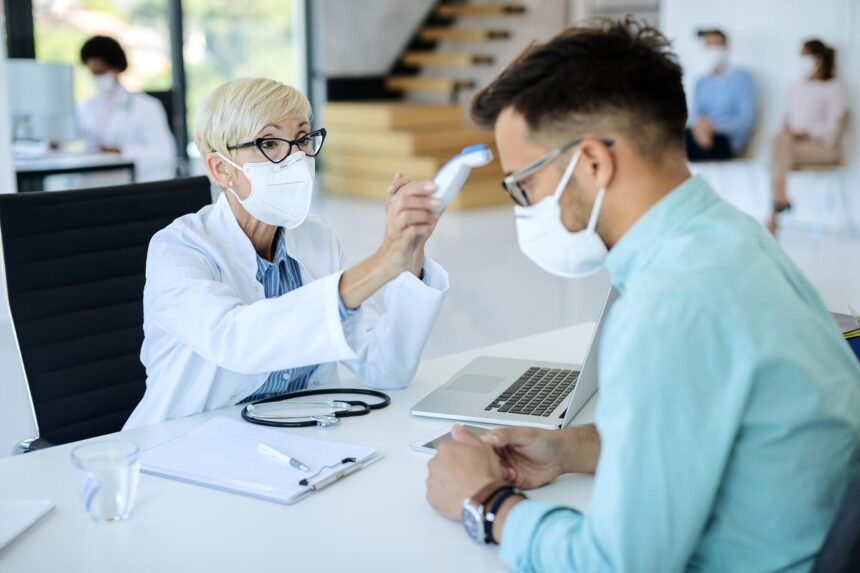COVID-19 questions have prompted medical practices to critically evaluate and enhance their safety protocols to protect both staff and patients during the pandemic. Adhering to recommendations from the Centers for Disease Control and Prevention (CDC), medical facilities are implementing comprehensive strategies to reduce the risk of virus transmission. This includes enforcing source control measures, ensuring proper use of personal protective equipment (PPE), and maintaining rigorous hygiene practices.
This guide answers essential questions regarding the implementation of these safety protocols, providing actionable advice and detailed steps to maintain a safe and effective healthcare environment amid ongoing challenges.
1) How can a medical practice establish effective medical staff safety protocols?
The CDC recommends the following best practices:
· Implement source control for all visitors, patients, and staff entering your practice or health care facility, regardless of symptoms.
· Encourage patients and visitors to wear cloth masks when visiting to prevent transmission from non-symptomatic individuals.
· Screen patients and visitors for symptoms of acute respiratory illness (e.g., fever, cough, difficulty breathing) before entering your health care facility.
· Ensure proper use of personal protective equipment (PPE).
· Conduct an inventory of available PPE.
· Encourage sick employees to stay home.
Helpful links:
2) What steps can healthcare professionals take to stay healthy during the COVID-19 pandemic?
The CDC recommends specific safety measures that health care professionals can take to minimize exposure to PUI and confirmed COVID-19 cases and prevent the spread of infection within health care facilities.
Those steps include:
· Implement source control for everyone entering a health care facility (e.g., health care personnel, patients, visitors), regardless of symptoms.
· Set guidelines to help triage patients with symptoms congruent with COVID-19.
· Utilize sanitation and hygiene stations.
· Demonstrate proper use of PPE, including eye protection.
· Assist in monitoring and restricting access for visitors and other nonessential personnel.
Helpful link:
3) Are N95 masks the standard of care?
Dental: The highest-rated masks generally recommended for use in dental settings are N95 respirators, which are evaluated, tested, and approved by the National Institute for Occupational Safety and Health (NIOSH), a part of the CDC. N95 respirators filter at least 95% of airborne particles. They should be used when treating patients with or suspected of having respiratory illnesses. However, most dental practices should not need N95 respirators except perhaps for emergency treatments – with proper triaging, the treatment of patients presenting with symptoms of respiratory illnesses should be postponed until a later time when they have fully recovered. Interim guidelines state that the highest level of PPE should be available when treating patients.
Medical: Medical staff working in a medical office need to wear a mask when seeing patients for appointments. A surgical face mask is appropriate to wear. The highest level of PPE should be available when treating patients.
Helpful links:
4) How should PPE be disposed of after examining a patient?
If the disposable PPE is not visibly soiled with bodily fluids or splatter, then disposable PPE can be discarded in the regular trash. If the PPE is visibly soiled and/or has splatter on it, it needs to be disposed of in the appropriately marked Biohazard container.
5) Can the HCP that have had exposure to COVID-19 patients go to work normally?
Asymptomatic HCP with a recognized COVID-19 exposure might be permitted to work in a crisis capacity strategy to address staffing shortages if they wear a facemask for source control for 14 days after the exposure. This time period is based on the current incubation period for COVID-19, which is 14 days.
6) Can I use hand sanitizer in between patients if my hands are not soiled during this COVID pandemic?
Yes, unless soap and water are not available. Wash your hands after each patient for no less than 20 seconds.
7) How do I know I have disinfected an exam room properly during the COVID pandemic?
Using an EPA-registered disinfectant product is best. Always be aware of the kill time for the product in use. This will insure proper disinfection. This should be documented in your infection control protocol.
To get answers to your COVID-19 questions, contact MedSafe
MedSafe is the nation’s leading one-stop resource for outsourced safety, training, and health compliance solutions. We offer a wide variety of onsite and online training courses, including OSHA Safety, Corporate Compliance, HIPAA, Billing Compliance, and Harassment and Discrimination in the Workplace.
Contact us today for a free training consultation.
Toll-free: (888) MED-SAFE

Leave a Reply
You must be logged in to post a comment.